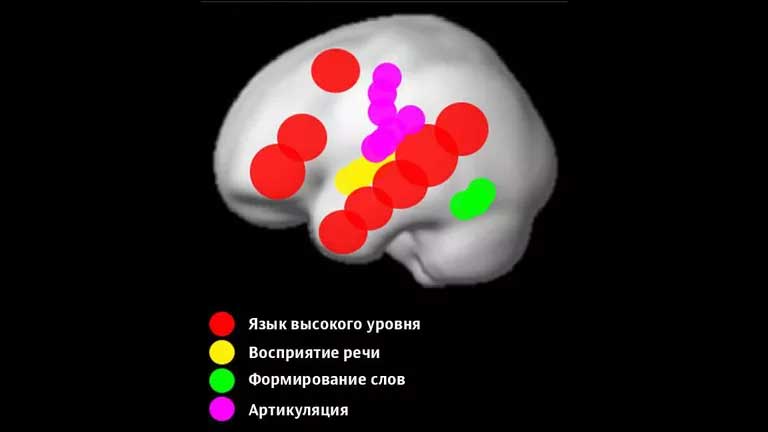Inner monologues are considered to be an imitation of overt speech. However, for a long time, the study of inner speech was difficult because people in studies expressed their thoughts in words, even if they were not actually thinking in words. Most thoughts actually happen in the background, without our knowledge, and there is no way to turn these things off. A few years ago, scientists from MIT (USA) discovered that Broca’s area in the human brain actually consists of two sections. One is responsible for speech, the other is activated when solving problems that require serious mental effort. This contradicts the hypothesis that without language there is no thinking.
If you’ve ever imagined an argument in your head, you may have “heard” two voices at the same time. Your own inner voice and the voice of the other person in the argument. You may even “hear” the other person’s accent or the timbre of their voice. So what’s going on in the brain when this internal monologue is going on? How is it that you can “hear” your own thoughts?
It turns out that when you think about words, the same processes occur in your brain as when you say them out loud.
Inner monologues are thought to mimic overt speech, says Hélène Löwenbrück, a senior researcher in neurolinguistics and head of the language group at the Laboratory of Psychology and Neurocognition at CNRS, a national French research institute. When we’re children, we’re virtual sponges, soaking up new information from all sides. Children playing alone often vocalize dialogues, such as between a toy truck and a stuffed animal. Around age 5 to 7, this verbalization moves inward, says Löwenbrück.
Earlier research has shown that the brain is similarly active during inner speech as it is during verbal speech. When study participants are asked to deliberately “talk” to themselves while lying in an MRI machine, scientists can see the parts of the brain that process auditory information light up, as if the participant were actually hearing the words.
The areas of the brain activated during inner speech are very similar to those activated during overt speech during real speech. These areas include the left frontal lobe and the parietal lobe, which help process external stimulation.

But when you think about something like a fictitious argument with another person, your brain takes it a step further. During this internal argument, you play two roles: yourself and the person you’re arguing with. When you play yourself, the auditory centers on the left side of your brain light up, Levenbrook said. But when you internally switch roles to play the person you’re arguing with, “there’s kind of a shift in brain region activation to the right hemisphere,” in equivalent areas like the parietal lobe and frontal lobe, she continued. Seeing a situation from a different perspective, even if it’s a perspective you create in your head, changes which areas of the brain are activated.
Researchers have also observed this phenomenon when participants are asked to imagine movement. Dancers, for example, use a different part of their brain to imagine themselves dancing rather than someone else, according to a study published in the August 2005 issue of the journal Cerebral Cortex.
It’s one thing to see these areas of the brain light up when a person is told to think about something, but there’s much less understanding of what’s going on in our brains when we let our minds wander, Leowenbruck said. Not all internal monologues are intentional. Sometimes words or sentences just pop into our heads, for no reason.
The phenomenon may be linked to the brain’s “default mode network” (DMN), said Robert Chavez, a neuroscientist at the University of Oregon. The DMN is a network of areas in the brain that are active when the brain is not engaged in a specific task. The DMN is thought to be associated with aspects of internal thinking, such as retrieving memories, imagining the future, or interoception — the sense or “feel” of what’s going on in your body, such as hunger or thirst.
The default mode network appears to be more active when your mind is wandering. Because the default mode network involves planning for the future by drawing on memories, recent experiences, and mental associations, this combination of activities is thought to produce an internal monologue while you are focusing on yourself.
Much more research is needed to understand how inner thoughts arise spontaneously. Inner thoughts taken to extremes can become dysfunctional, such as rumination after an upsetting or traumatic event, or in mental disorders such as schizophrenia, in which people experience auditory hallucinations.
For a long time, it was believed that the inner voice was simply a part of the human being. But it turns out that this is not true – not everyone perceives life in words and sentences.
“By interior monologue, we mean that we can have a private speech addressed to ourselves and conducted without any articulation or sound,” says Hélène Loewenbruck, a senior researcher in neurolinguistics and head of the language group at the Laboratory of Psychology and Neurocognitive Sciences at CNRS, France’s national research institute.
With true inner speech, you almost “hear” your inner voice. You are aware of its tone and intonation. For example, the voice may “sound” angry or worried. Research has shown that children as young as 5 to 7 years old can use an inner voice, and some research suggests that children may use some form of inner phonics as early as 18 to 21 months.
Loewenbruck’s research looks at internal monologues in three dimensions, according to a 2019 study she and her colleagues published in the journal Frontiers in Psychology. The first is dialogicity. People can have such complex inner speech that there’s debate about whether all inner speech is properly called a monologue. So the first dimension measures whether you’re thinking in a monologue or a dialogue. A monologue happens when you think to yourself something like, “I need to buy some bread.” But other times, when you’re reasoning, you may be taking into account and engaging multiple perspectives — like a conversation, a dialogue.
The second dimension is condensation, a measure of how verbose your inner speech is. Sometimes you think in words or fragments. But other times, like when you’re preparing for a talk or presentation, you’re more likely to think in sentences and paragraphs.
The third dimension is intentionality. Do you engage in inner speech intentionally? For reasons unknown to us, inner speech can sometimes just come to you or move on to completely random and seemingly unrelated topics.

However, for a long time, the study of inner speech was hampered by the fact that in the course of research people expressed their thoughts in words even if they were not actually thinking in words.
This long-held assumption that all humans rely on an inner voice was first challenged in the late 1990s, thanks in large part to a study conducted by Russell Hurlburt, a psychologist at the University of Nevada, Las Vegas. Hurlburt studied the inner speech of participants by asking them to wear a pager. Whenever the device beeped, they were asked to write down what they were thinking or experiencing in their minds just before the sound. At the end of the day, they met with a researcher to discuss their answers.
Perhaps a participant wrote down, “I need to buy some bread.” The researcher would then ask if they really thought that. “Or did you think ‘bread’? Or were you hungry, or did you have a feeling in your stomach?” Loewenbruck explained. With each encounter with the researcher, the participants became better at articulating their true thoughts. Eventually, the methodology showed that some people had inner speech every time the device beeped, almost like “they had a radio in their head.” But others had less inner speech than usual, and some had no inner speech at all. They experienced images, sensations, and emotions, but no voice or words.
The lack of an internal monologue has been linked to a condition called aphantasia — sometimes called “mind’s eye blindness.” People who experience aphantasia don’t experience visualizations in their minds; they can’t picture their bedroom or their mother’s face in their minds. Often, those who don’t experience visualizations don’t experience clear internal speech, either, Levenbruck noted.
Aphantasia and the absence of an inner voice are not necessarily bad. But a better understanding of inner speech and the wide range of thought processes that people experience may be particularly important “for teaching methods and education in general. Until now, the types of inner speech and experiences that children may have, and the resources they may need to learn, have probably been greatly underestimated.
Can we ever really stop thinking?
“It depends on how you define ‘thinking,’” said Michael Halassa, an associate professor of brain and cognitive science at the Massachusetts Institute of Technology. A thought, which is the result of a chemical reaction between brain cells, can occur at either a conscious or unconscious level.
The type of thinking we are aware of, such as the endless thoughts that pop up when we try to sleep, can theoretically be silenced. That may be what meditation is all about, Halassa said.
But even though that’s what meditators aim for, it’s unclear how empty a state they can actually achieve. “I don’t know if it’s theoretically possible to stop thinking entirely, and if it is, I think it would be incredibly difficult to test,” said Julia Kam, a cognitive scientist at the Knight Lab at the University of California, Berkeley.
But obviously meditators are much more attuned to what they’re thinking. So when they have to focus on something and their mind wanders, they’re just much better at picking up on that shift in attention.
There’s a difference between having a thought and being aware that you’re having a thought, she said. So if you ask someone what they’re thinking about and they say “nothing,” they may simply not be aware that they’re having a thought. For example, you may be deep in thought about a relationship or an upcoming test, and you only become aware of it when someone taps you on the shoulder and snaps you out of it. People who think “nothing” may also have a stream of thoughts in their mind that don’t tell a coherent story.

But the brain never actually stops “thinking” in the broader sense. Most of our thinking actually happens in the background, without us even realizing it, and there’s really no way to turn these things off.
If you see a familiar face in a crowd and think you know them, you may not be able to immediately figure out where you know them from. But maybe a few hours later you’ll suddenly remember. This is the result of your brain “thinking” in the background.
Even decision making happens largely unconsciously. For example, some of this background “thinking” leads to what we call a “gut feeling.” Often, our brains crunch a bunch of numbers and come up with a gut feeling that we end up following. We don’t always have conscious access to the decision-making process in our brains, and sometimes we create a story to explain a decision—sometimes it’s accurate, sometimes it’s not.
How you define “thinking” changes the answer to the question. If you mean thinking as an internal dialogue with yourself, then yes, we can stop that internal dialogue. But if thinking means not focusing on something specific, it will be much more difficult for the layperson.
Even as we sit here reading this, thinking about thinking, we are sending messages down a chain of neurons in the brain. So if we somehow manage to stop “thinking” consciously, or achieve an “empty state of mind” through meditation, the brain will not switch off. It will continue to have thoughts – we just won’t be aware of them.
Several years ago, scientists from MIT (USA) discovered that Broca’s area in the human brain actually consists of two sections. One is responsible for speech, the other is activated when solving problems that require serious mental effort. This contradicts the hypothesis that without language there is no thinking.
In the late 1970s, Susan Schaller came to Los Angeles to work as an English teacher at a college for the deaf. There she met a young man named Ildefonso, who, to her surprise, at 27 years old, did not know sign language. Ildefonso, deaf from birth, grew up in Mexico in a family where everyone could hear. He did not learn sign language for the deaf, but simply copied the actions of his family and the people around him. Moreover, he did not suspect that the world around him was full of sounds. He thought that all people were like him.
Schaller gradually taught him sign language, reading in English, and counting. A few years later, she decided to write a book (published in 1991 under the title “The Man Without Words”) and met Ildefonso again. He invited her to visit his friends, deaf from birth, who, like him, did not know sign language and had invented their own way of communicating with intense facial expressions and complex pantomime.
Two years later, Schaller interviewed Ildefonso again and asked him about his deaf friends. He replied that he no longer met them because it was hard for him, he could no longer think like them. And he could not even remember how he had communicated with them before. Having learned the language, Ildefonso began to think differently.
In the 1970s, the first school for the deaf opened in Nicaragua. They gathered fifty children from ordinary families. No one knew a universal sign language – everyone had their own way of communicating. Gradually, the students invented their own sign language, and the next generation improved it. This is how the Nicaraguan sign language was born, which is still used today.
As Columbia University’s Anne Senghas, who has studied schools for the deaf in Nicaragua, writes, this is a rare case that helps us understand that children don’t just learn language, they invent it as they interact with others and the world around them. And the language is constantly being modified, with the main changes occurring in children aged ten and younger.
Elizabeth Spelke from Harvard has shown that children begin to combine different concepts in their heads to solve everyday problems from the age of six. At this age, the child has already mastered the language and uses it for spatial navigation. For example, he will figure out that to get to the right house, he needs to go left along the green fence. Here, two concepts are used at once – “left” and “green”.

The brain regions responsible for generating different aspects of language. Scientists from MIT studied high-level language: the ability to form meaningful utterances and understand the meaning of utterances of others. PMC/US National Library of Medicine National Institutes of Health
Rats in a similar situation succeed only half the time, that is, the result is purely random. These animals are perfectly oriented in space, they know where left and right are. They distinguish colors. But they are not able to orient themselves by a combination of direction and color. They do not have a corresponding system in their brain. And this system is language.
Charles Fernyhough of Durham University (UK), who conducted experiments on rats, holds a rather radical point of view. He believes that thinking without language is impossible. Proof of this is that we always think in phrases, this is called inner speech. In this sense, the scientist believes, small children who cannot yet speak do not think.
On the other hand, much in the mind is expressed not by words and sounds, but by pictures and images. This is evidenced by the experience of those who have suffered a stroke. Here is how Bolti Taylor, a neurologist from the USA, described it in her book “My Stroke Was a Lesson to Me”.
She got out of bed in the morning with pain behind her left eye. She tried to do exercises on the exercise machine, but her hands wouldn’t obey her. She went to the shower and lost her balance. Then her right hand became paralyzed and her inner speech completely disappeared. Already in the hospital, she forgot how to talk, and her memory also disappeared. She didn’t know her name or how old she was. There was complete silence in her brain. Taylor gradually learned to communicate. If she was asked who the president of the country was, she imagined the image of a male leader. Only after eight years of rehabilitation did her speech return.
The fact that internal speech is not critical for thinking is also shown by the work of Evelina Fedorenko from the Massachusetts Institute of Technology. She and her colleagues study people with global aphasia, in which the brain centers responsible for speech and language are damaged. These patients do not distinguish words, do not understand speech, cannot form understandable words and phrases, add and subtract, or solve logical problems.
It is believed that language is a means of communication not only between people, but also between different cognitive systems of the brain of one person, for example, those responsible for spatial orientation or arithmetic. A good example is the Pirahã tribe from the Amazon. Their language does not have numerals, and when solving some simple problems – for example, taking the same number of sticks as balls – they make mistakes.
Fedorenko’s group showed with the help of fMRI that patients who had suffered a stroke in the left hemisphere of the brain have major problems with language and arithmetic. However, patients with aphasia retain the ability to do arithmetic. Moreover, they cope with complex logical cause-and-effect problems, some continue to play chess, which actually requires special attention, working memory, planning, and deduction.
Humans are distinguished from other animals by language, as well as the ability to understand others, to guess what is on their minds. Fedorenko’s data convinces us that if an adult has this ability, then language is not necessary for expressing their own thoughts.
Another unique human quality is the ability to perceive and compose music. This is very similar to the ability to language: sounds, rhythm, intonations are also involved, there are rules for their use. It turns out that patients with aphasia understand music. Soviet composer Vissarion Shebalin, after two strokes of the left hemisphere, could not speak, understand speech, but continued to compose music, and at a level comparable to what he had before the disease.
Based on neuroscience data, the authors of the study conclude that language and thinking are not the same thing. People who have suffered a stroke, suffer from aphasia, and have lost language, have a wide range of thinking capabilities based on neural systems that are more basic than the language system. Although initially, in childhood, these systems developed with the help of language.






